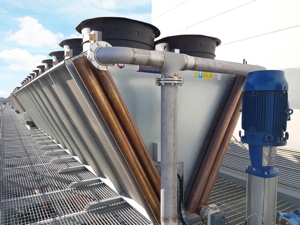Change is in the air

Is there a shift in cooling preferences for data centres? Tim Bound looks at the ambient cooling option and its growingpopularity in the face of rising energy costs.
As demand for data collection, storage and exchange multiplies at an unprecedented rate, experts are concerned that the energy consumption of data centre infrastructure is becoming an increasing drain on the world’s energy resources.
In an era where on an annual basis, data centres in the United States alone consume the entire output of 34 of the world’s largest power stations, methods of conserving and reducing the energy input of some of the globes most socially and economically critical buildings is more important than ever.
By 2020 the UK will be the largest single market in Europe for data centres, and analysts predict this will cost the industry up to £7 billion per year in energy alone. Disclosure of data centre energy and carbon performance metrics is now driving change in a sector where the potential energy savings could comfortably sit in the hundreds-of-millions.
There are a number of ways to deliver power savings in data centres, from optimising renewable energy sources, to updating the physical infrastructure of the building, investing in modern server technology with lower heat emissions, or carefully specifying the right cooling equipment.
Shift to ambient
Historically, data centres have been cooled using compressor or refrigerated technology, often with an adiabatic cooler installed to dissipate the heat generated by the compressor. The performance of this conventional chilling technology has serviced the mission critical data centre sector well thus far, but change is definitely afoot.
 |
|
A re-think on cooling - rising energy costs mean changing views on cooling technologies for data centres |
There is a distinct shift in popularity from traditional compressor based chilling methods to far more energy efficient ambient cooling technologies, with a particular focus on adiabatic solutions due to its retrofitting capabilities compared to other ambient systems such as direct evaporative or heat exchanger technology. Why? The two main drivers for change are a surge in investment in the constructionof new or extended data centres, plus a significant improvement in the operating parameters of server technology.
The global data centre construction market is estimated to grow from $14.59bn in 2014 to $22.73bn by 2019, at a Compound Annual Growth Rate (CAGR) of 9.3%. This thriving market growth is down to many companies transforming traditional facilities into mega data centres and others planning to build new ‘monster sites’ in the coming years.
With modernisation, comes state-of-the-art server technology which is capable of withstanding higher temperatures whilst maintaining optimised performance and reliability.
The modernisation of legacy data centre infrastructure, the increased construction of new ultra-modern sites and the widespread adoption of more temperature resilient servers has driven a desire for compressorless cooling, choosing the energy efficient benefits of ambient cooling technologies instead.
Time is right
Historically, ambient cooling equipment has been unable to cool data centres to within the right temperature range, which created an industry reliant on refrigerated or compressor led solutions. Now, thanks to more adaptive build methods and the marginal, but vital, increase in server temperature resilience, the temperature parameters of data centres has risen to a range which ambient cooling technology can comfortably achieve.
In other words, instead of cooling the compressor, adiabatic equipment is now directly cooling the data centre equipment itself. This is reducing capital expenditure by eradicating an entire chiller from many new build specifications.
 |
|
Cooling solutions for data centres |
Energy efficiency
Adiabatic and other ambient cooling equipment achieves lower Energy Efficiency Ratios (EER) than compressor-based chillers. Take the example of a typical compressor chiller which will consume 1kW of energy for every 3-4kW of cooling delivered.
Compare this to an equivalentsized adiabatic solution, which for the same 1kW of energy consumed, will deliver up to 75kW of cooling.
In terms of EER, this difference translates as an approximate EER of 4 (4kWth/1kWe) for a conventional compressor solution, and an impressive EER of around 75 (75kWh/1kWe) for the equivalent ambient solution. This of course, translates to substantial energy and cost savings for energy-hungry mission critical environments.
Legacy systems
Older data centres which house older-style servers will still rely on compressor or refrigeration chillers to dissipate enough heat from the data centre, and maintain an internal building environment which meets the operational temperature thresholds of dated server technology.
That said, given that most leading ambient coolers are installed externally, retrofitting additional cooling technology to supplement an existing compressor solution is a highly viable option for many older data centres looking to maximise geographical assets and weather patterns to deliver free cooling during certain seasons.
If an older data centre retains its legacy infrastructure but is refitted with state-of-the art servers which can operate at higher temperatures, adiabatic cooling equipment can be retrofitted to the same inlets as older equipment.
As the data centre industry evolves and grows at a rapid pace, energy conservation focused industry leaders like Facebook have already maximised ambient and free cooling technologies within their data centres. As we move towards a future even more reliant on the storage and exchange of data, the rest of the industry is expected to follow suit.
Tim Bound is sales director for Transtherm Cooling Industries







